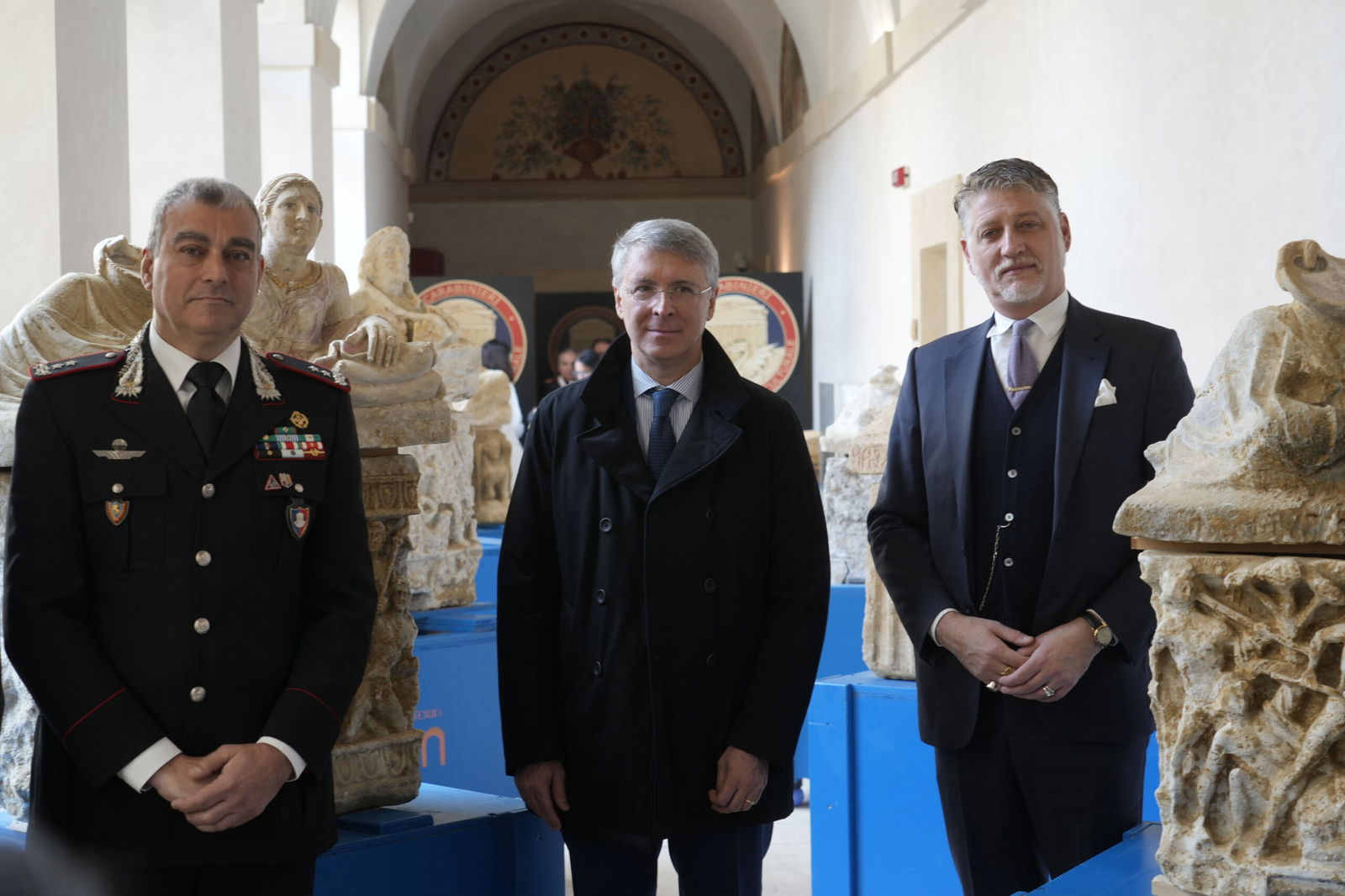Around the World briefs

By Associated Press
Italy recovers Etruscan artifacts worth $8.5 million bound for black market
ROME | Italian authorities announced Tuesday the seizure of an illegal excavation of an Etruscan burial site in the central Umbria region and are investigating two people for suspected theft of urns, sarcophagi and other artifacts worth 8 million euros ($8.5 million) intended for sale on the black market.
The illegal dig was adjacent to another Etruscan burial site discovered by a farmer tilling his land in 2015, authorities said. They were tipped off by photographs of artifacts and the site that were circulating on the black market that resembled objects found on the farmer’s land.
Using a drone for aerial photography and phone taps, they located the second site on land belonging to a local businessman who had access to earthmoving equipment.
At the new site they found two sarcophagi, believed to be of two Etruscan princesses, one still with the skeleton inside, and a burial trousseau complete with urns with battle and hunting scenes, perfume jars and a comb made from bone.
The Etruscan civilization existed from about 900 B.C. to 27 B.C. in central Italy primarily between the Tiber and Arno rivers, covering parts of present-day Tuscany, Umbria and Lazio.
School closures and travel
delays as Arctic air brings snow
and sleet to parts of the UK
LONDON | Dozens of schools closed and road and train travel ground to a halt in many parts of the U.K. on Tuesday as a cold snap brought snow, ice and sleet across the country.
Britain’s weather forecasters, the Met Office, issued snow and ice warnings and said an Arctic maritime air mass was spreading from the northern U.K. southwards. Power cuts may occur and rural areas could be cut off due to the severe weather, it said.
Around 200 schools across the U.K. closed their gates, while thousands of commuters faced disruption to their journeys as dozens of train services were cancelled or delayed by snow on the tracks.
A Stagecoach bus toppled onto its side on Tuesday in Scotland due to icy road conditions. One passenger was on board and there were no injuries.
The Met Office said up to 5 centimeters (2 inches) of snow is likely to blanket many parts of the country, with up to 20 centimeters expected to accumulate at higher altitudes. Much of the U.K. saw sub-zero temperatures overnight on Monday, with the thermostat dropping to 11 degrees Celsius below zero (12 degrees Fahrenheit) in Aberdeenshire, Scotland.
The UK Health Security Agency issued its first cold weather health alert of the season, saying conditions could be dangerous for elderly and other vulnerable people.
Virgin Mary statue, a symbol of resilience, returns to Notre Dame Cathedral five years after fire
PARIS | A medieval statue of the Virgin Mary and Child, known as “The Virgin of Paris,” returned to Notre Dame cathedral Friday evening, five years after surviving the devastating 2019 fire that engulfed the landmark.
The nearly six-foot-tall stone sculpture, a symbol of hope and faith for Catholics in Paris and beyond, was relocated after the blaze on April 15, 2019.
Miraculously intact, it earned the nickname “Stabat Mater” — the standing Virgin — as a sign of resilience amid the destruction.
The statue’s return began with a torchlit procession from the forecourt of Saint-Germain-l’Auxerrois Church. Hundreds of faithful and residents accompanied the statue along the Seine river to the cathedral’s square, where Archbishop Laurent Ulrich of Paris led a blessing ceremony.
“Tonight, as we accompany the Virgin Mary to her cathedral, before she takes her place at the pillar where so many generations have come to pray, we know she is joining the house of Christ,” Ulrich said, bowing before the statue and blessing it with incense.
The statue, originally from the Saint-Aignan Chapel on the Île de la Cité, dates to the mid-14th century. Moved to Notre Dame cathedral in 1818, it was relocated several times before finding a permanent home in 1855 against the southeast pillar of the cathedral, under the guidance of architect Eugène Viollet-le-Duc, according to a news release from the cathedral.
A vigil followed, concluding a nine-day prayer cycle that began Nov. 7.
The ceremony is part of the lead-up to the cathedral’s grand reopening, scheduled for Dec. 8.
Last Thursday, the cathedral took delivery of three new bells, including one used in the Stade de France during the Paris Olympics earlier this year. The Olympic bell, a gift from the Paris 2024 organizing committee, will join two smaller bells, Chiara and Carlos, above the altar.
“We’ll be together again in a few days to open the door to Christ,” Ulrich said during the ceremony.
The mausoleum holding Congo independence hero Lumumba’s gold-capped tooth is vandalized
KINSHASA, Congo | Congo’s government says the mausoleum of assassinated independence leader Patrice Lumumba in the capital, Kinshasa, has been vandalized. It’s not immediately clear whether Lumumba’s remains — a single gold-capped tooth — were damaged or stolen.
A mausoleum curator told the national press agency that the coffin containing the tooth was broken Monday.
The glass doors were smashed and four suspects were arrested, the deputy mayor of the neighborhood where the mausoleum is located told the country’s main radio channel. He added that he couldn’t confirm whether the tooth was stolen or not.
It’s not clear who was responsible for the act of vandalism, Congo’s ministry of culture said in a statement Tuesday.
The return of Lumumba’s tooth from former colonizer Belgium in 2022 had been celebrated around Congo, with the tooth taken around the vast country so people could pay their respects.
Lumumba is widely hailed as the nationalist activist who helped to end colonial rule. He became Congo’s first prime minister and was seen as one of Africa’s most promising new leaders, but he was assassinated within a year in 1961. His body was dismembered and dissolved with acid in an apparent effort to keep any grave from becoming a pilgrimage site.
For many in Congo, Lumumba is a symbol of the positive developments the country could have achieved after its independence. Instead, it became mired in decades of dictatorship that drained its vast mineral riches.
Historians say Lumumba was a victim of the Cold War. He promoted leftist policies, and when he reached out to the Soviet Union for help in putting down a secessionist movement in the mineral-rich Katanga region, he fell out of favor with Belgium and the United States.
A military coup toppled Lumumba, and he was arrested, jailed and later killed. His assassination, blamed on separatists, cleared the way for the rise of Mobutu Sese Seko, who ruled the country he later renamed Zaire for decades with support from Western powers until his death in 1997.
Even though Lumumba’s killers were Congolese, questions have persisted over the complicity of Belgium and the United States because of his perceived Communist ties.
His one remaining tooth was kept by the Belgian police commissioner who oversaw the destruction of his body. In 2016, the tooth was seized by Belgian officials from the police commissioner’s daughter.
The tooth was returned to Congo after the visit of Belgium’s King Philippe, who expressed regrets for his nation’s abuses in Congo when it was a Belgian colony.
—From AP reports


